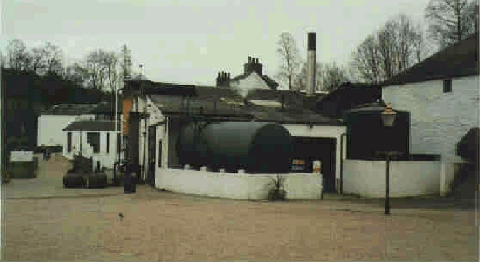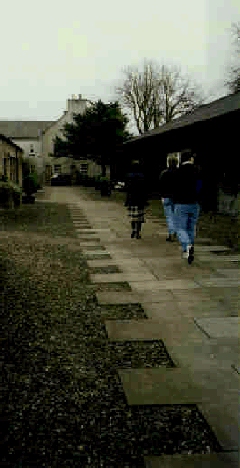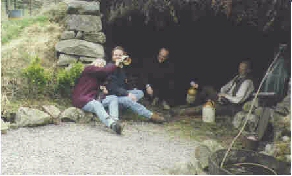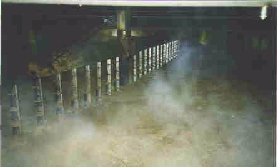Omaha
Scotch Watch
Newsletter

Omaha
|

|
May, 1998
|
In this newsletter and others to follow, we will provide both the highlights and most memorable experiences of the trip.
Clearly the 15 distilleries visited were exceptional, but it was the people that made memories that will last forever. Dru at Dalmore, Russell at Macallan, Bill and Glenfarclas, Katherine at Glenmorangie, Ian at Laphroig, Donny at Lagavulin, Christine at Bowmore, Jackie and Stuart at Ardbeg, Isabella at Glenkinchie, Jennifer and Patricia at Fettercairn, Marion at Royal Lochnegar and Alester at Caol Isla blessed us with the knowledge, their hospitality and their kindness.
Finally, our driver Alan, whose patience, sense of humor and willingness to put up with the yanks in his charge made this an experience to cherish.
The distillery uses water from the River Turrett and as with almost all the locations we visited, Glenturrett does not do their own maltings but rather contract with companies that do this form them to their specifications.
The Mash Tun was quite small and actually had no top. The Mash Tun is the vessel which is used to remove the sugars from the barley mash. This is done through the infusion of water at varying degrees of temperature. At
Glenturret, as with all distilleries we visited but Strathisla, three infusions of water were carried out varying in temperature from 64 to 89 degrees centigrade.
From the Mash Tun the sugarary mixture called worts is transferred to washbacks. These vessels are where the fermentation takes place with the addition of either distillers or brewers yeast. Glenturret's eight washbacks were made of oregon pine and stood 5 meters tall. As with most distillation processes, the yeast equals 1 percent per volume of worts.

Glenturret Distillery - Picture by B.J. Reed
Fermentation at Glenturret takes approximately 48 hours at which time an alcoholic substance, much like beer of 7 to 8 percent alcohol is produced. This alcoholic substance is then sent to the first of two stills, called a wash still. Here it is heated so that the alcohol is vaporized and re-condensed into a solution that is approximately 20 percent alcohol. It is then recycled through the spirit (or low wines) still where it is again heated, vaporized and condensed to make the spirit that is to become single malt whisky. The spirit still at Glenturret contains 12,600 liters and this distillery has only one wash still and one spirit still reflecting its small size and production capacity.
Glenturret is owned by Highland Distillers and produces a number of single malt bottlings in ages that range from 12, 15, 18,25 and 27 years. Most of these are sold on the premises which makes Glenturret difficult to obtain in The United States.
| Jennifer and Patricia were our tour guides at Old Fettercairn, another small distillery on the way from St Andrews to The Highlands. This distillery is owned by White and McKay who also own Tomitoul, and the Isle of Jura. |

Old Fettercairn Distillery - Photo by B.J. Reed |
Jennifer noted that Fettercairn's malting specifications require only a light peating of their barley malt occurs. The malting process will be described in detail at a later point but it should be noted here that most highland and speyside malts specify that as the barley malt is dried that only small amount of peat smoke is blown into the barley. In the case of Islay malts, this amount of peat smoke is much higher. |
The Mash Tun at Fettercairn is 5 tons and infuses its water at 64,74 and 84 degrees centigrade. The last infusion of water is referred to as sparge and results in the barley mash having only about 1 percent sugar content by that time. Almost 32,000 liters of water is infused into the Mash Tun during this process.
Fettercairn has 3 washbacks and here they add approximately 100 kilograms of yeast for 26,000 liters of worts (the sugary liquid that is pumped from the mash tun) - this produces about 8 percent alcohol.
Fettercairn also has a large Wash Still holding 17, 272 liters of liquid while its spirit/low wine still holds 13,638.
Once the second distillation in the low wine still has been completed, the alcohol runs through the spirit safe. The first part of the run is referred to as the foreshots. This spirit is discarded and recycled into a second run through the low wine still because of its impurities. The middle cut is retained at the discretion of the stillman and this middle cut is based on the clarity of the spirit and the volume proof of alcohol produced. The end of the run is called the feints and it too is recycled into the low wine still.
This decision, in part, is based on the lowering of the proof of alcohol being produced. Once the alcohol and liquid remaining after the second distillation can no longer produce a quality product, it is discarded. This discarded liquid is referred to as spent lease .
At Fettercairn, the foreshots and feints take approximately 20 minutes while the middle cut is about 2 « to 3 hours long.
Once the middle cut has been selected, it is placed into casks. There are three sizes of casks, Butts which are 500 lbs, Hogsheads which are 250 lbs and Barrels which are 100 lbs. Fettercairn uses oak casks up to 3 to 4 times and bottles its single malts at ten years using a combination of casks depending upon how often they have been used to ensure a consistent product.

ScotchWatch members enjoying a display of early distillation practices
at Royal Lochnagar.
Picture by B.J. Reed
United Distillers owns Royal Lochnagar among many other distilleries throughout Scotland. The water comes from a spring close to the distillery. The last floor maltings were done in 1967. This is true for many of the distilleries we visited. Because of an economic downturn in the late 60s and early 70s many gave up malting their own barley. The barley used by Royal Lochnagar is Derkato a popular variety. As noted earlier they purchase the barley from malters after they have malted it to their specifications.
The Mash Tun at Royal Lochnagar uses 3 infusions of water at 63, 75 and 83 degrees centigrade. It takes 4 « hours to fill the Mash Tun here. The produce 4 tons of mash and 8,000 liters of spirit per week. 27,000 liters of worts are produced by the Mash Tun and sent to the washbacks. Royal Lochnagar uses 2 washbacks at a time for each production of the Mash Tun. 120 kilograms of yeast are added to the 27,000 liters of worts for fermentation. The washbacks are made of Scottish Larchwood and last from 45 to 50 years.
Royal Lochnagar's fermentation is the longest of the distilleries we visited taking from 60 to 70 hours. The reason according to Marian was originally due to staffing since the Friday run from the Mash Tun to the washbacks did not move into the Wash Still until Sunday evening when the next crew change occurred. They actually preferred the product produced over this longer period of time and have now built it into their production process.
The wash still is quite small, only 7,410 liters. Each still has a window so the stillman can view the actual process to ensure that still is not overheating. Once the 20% alcohol is moved the the Low Wine still it is reheated to reach an alcohol content of 70 percent. The Royal Lochnagar Low Wine Still is also very small at 5,450 liters. Both stills are powered by steam heat as are most in the industry.
Marian noted that the parts of the still wear out at different rates with the top neck being replaced most often. She also noted that 95 percent of Royal Lochnagar is sold to blenders. Once the alcohol is produced from the Low Wine Still, the foreshots run for approximately 20 minutes and the middle cut for about 1 « hours. The feints run quite long, between 2 and 3 hours. The bottling of Royal Lochnagar is done in Fife, home of St Andrews. For the 12 year old bottling of Royal Lochnagar, a butt cask can produce about 800 bottles. It was interesting to note that the Select Reserve is chosen once a year from the managers pick of select barrels that they believe produces the finest whisky. Since the barrels may be of different ages, it explains while the Select Reserve has no age statement.
More of the trip will follow in future newsletters - Stay Tuned!!!

Inside of Mash Tun at Glenfarclas - Picture by Jules Vieau
The Scotch Watch is a joint venture of Bill Wakefield and B.J. Reed. Anyone with comments or suggestions may contact Bill at 553-3097 or B.J. at 556-5509. E-mail for B.J. is breed@fa-cpacs.unomaha.edu